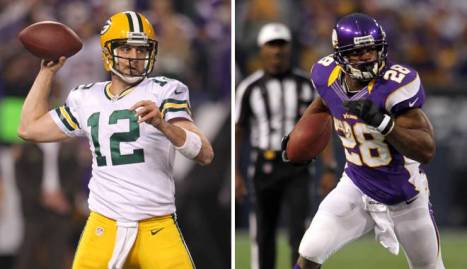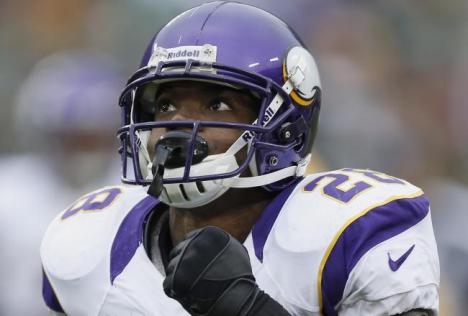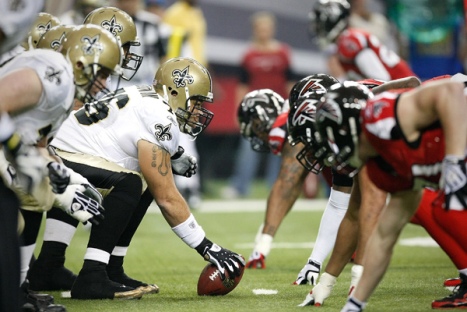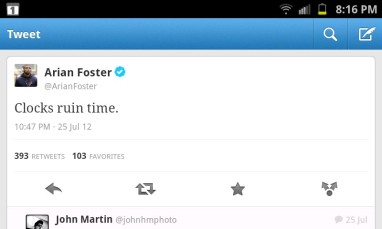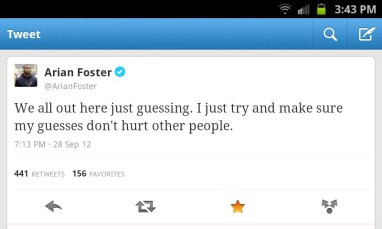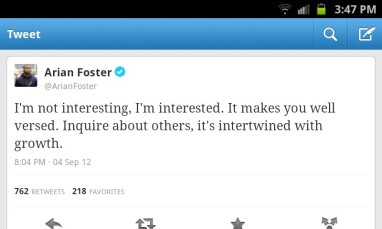Breaking down all of your favorite (and least favorite) Sunday commercials.
@BreakTheHuddle

Papa and Peyton, hanging out, saying the word “million” incorrectly (they say mee-yin) and giving away one – no, TWO – meeyin free… Papa John’s pizzas
‘‘Hate-watching provokes feelings of outrage, indignation, contempt or loathing so intense they become pleasurable.’’ – Slate Magazine’s “Culture Glabfest”
“By that logic, I must increase my hatred for games called by Jon Gruden. Because right now, it isn’t pleasurable. If I hate it more, I’ll love it more. Makes sense.” – Yours Truly
12:00 PM – The TV is on, FOX is the channel.
12:01 PM – I wonder how much local advertisers have to pay for the spots immediately before the game starts? You know people are tuning in in massive waves, and that has to be valuable airtime. Why am I seeing ads for Jimbo’s Liquor Store and campaign commercials for city council? Let’s get to the big time!
12:12 PM – There we go, our first Peyton sighting. He’s driving a Buick that lets him audible! How funny! Does Buick expect anyone to believe Peyton drives their vehicles? He’s old, but he’s not that old. Does Papa John ask Peyton at commercial shoots what his favorite pizza is? Come on, people. The man is worth more than $150 million and is a professional athlete. He drives a Mercedes and he eats caviar (and tapenade… but more on that later). It’s time to give up the ghost.
12:38 PM – Geico commercial featuring Gallagher. Damn, we’re off to a good start. The commercial opens with a square pants-looking suburbanite asking the sole proprietor of a farmer’s market about the carbon footprint of his kale. Suddenly, Gallagher zips into the screen and starts smashing the (assuredly eco-friendly) watermelons into bits, spraying everyone. Cut to two guys, one with a mandolin and the other a guitar, who deliver the punch line: “People who switch to Geico are happier than Gallagher at a farmer’s market.” They featured Gallagher, made fun of Just Local-eating nutjobs and used a mandolin. A+, Geico.
12:49 PM – Internet Explorer 9 commercial featuring that catchy-sounding song… It’s the Black Keys, right? Man, they’re good.
1:00 PM – MOVIE TRAILER: “Here Comes the Boom”, starring Kevin James. A fat teacher becomes an MMA fighter to save his school. I wouldn’t expect less from Kevin James. The question is: which Hollywood bombshell will play his love interest? James’ studio must not understand the term”suspension of disbelief”. He’s always ending up with women way out of his league – Rosario Dawson, Winona Ryder, Jayma Mays, Leah Remini AND OH MY GOD it’s Selma Hayek. This is their boldest move yet.
1:07 PM – State Farm – Discount Double Check commercial. Oh, all the times I heard “Discount Double Choke” jokes made after last year’s playoff debacle. Oh, Aaron, make them pull it off the air. I’m your biggest fan. But this commercial’s got to go.
1:21 PM – Dodge Dart – It’s a cool commercial – lots of jump cuts, quick hitting, even a little witty. Though in the words of my friend, Bernard, “That’s pretty cool commercial, but it’s still a s***y car.” Indeed.
 1:38 PM – Let’s play a game called “Acid Trip, or TV commercial?” The scene – there’s a freaky looking tree with a face and a lazy eye in a guy’s back yard, and when his friends need tickets to big games, they come over and ask the tree for tickets. He always obliges, because his leaves are actually the tickets, but he does so in clever ways. And the tree has a deep, goofy voice. If you guessed “acid trip” you’d be wrong! That’s a Stub Hub commercial, and whoever pitched it to Stub Hub’s executives trips acid twice a day for “inspiration”. I guarantee it.
1:38 PM – Let’s play a game called “Acid Trip, or TV commercial?” The scene – there’s a freaky looking tree with a face and a lazy eye in a guy’s back yard, and when his friends need tickets to big games, they come over and ask the tree for tickets. He always obliges, because his leaves are actually the tickets, but he does so in clever ways. And the tree has a deep, goofy voice. If you guessed “acid trip” you’d be wrong! That’s a Stub Hub commercial, and whoever pitched it to Stub Hub’s executives trips acid twice a day for “inspiration”. I guarantee it.
1:55 PM – Domino’s CEO Patrick Doyle is asking his delivery drivers for some tips on how to make the perfect pizza delivery vehicle. Oh, this ought to be fun! What will all the geniuses who deliver pizzas for a living have to contribute to this conversation?
– “We need an oven in the back seat,” says the first guy, who has no imagination whatsoever and leads a boring life.
– “You should put in a gyroscopic pizza holder – to keep the pizzas level!” says the attractive, annoying know-it-all young lady who tried really hard to come up with a big word she could use in this commercial.

“Flying delivery car, Mr. Doyle. Now PROMOTE ME!”
– “A flying car with a jet engine,” says the fat guy, pictured to the right, who probably wouldn’t be able to get airborne in a flying car in the first place.
– “Traffic mapping would be good,” says the one reasonable and realistic-looking person featured in this ad… by realistic-looking, I mean he looks like most pizza delivery guys. And by that, I mean – he definitely knows where you could buy some weed.
-“A tank,” says the middle age loner who scares the beJesus out of everyone and plays Modern Warfare every waking second he isn’t delivering pizzas.
Yeah, productive, guys. Well done! The best and brightest Domino’s had to offer really came through, there!
2:13 PM – Internet Explorer 9 – “And it FEELS LIKE I AM JUST TOO CLOSE TO LOOOOVE YOU” wubwubwubwubwubWUBWUBWUBwubwubwub
2:26 PM – Steve Sabol tribute – poignant, simple and beautiful. We see an illuminated stadium with a camera, rolling tape, as it slows and comes to a stop. The lights go out, and we pan to the night sky, one star shining brighter than the rest. The following words appear on the screen: “Your light will shine forever on the game you loved. Steve Sabol, 1942-2012.”
Corny? Maybe. But Sabol is as responsible as anyone for the NFL being as accessible and well-covered as it is today. On a personal note, my first encounters with the game of football were hand-me-down ‘Football Follies’ films, shot and narrated by Sabol himself, in the early 90s. I played them on an endless loop throughout most of my early childhood – the man had a gift for making those gridiron warriors seem human, and for giving the fans a peek behind the scenes of NFL games.
2:48 PM – NFL Sunday Ticket spot – one of their many, but I’d like to highlight this one, as it features tapenade. For those of you who don’t know, tapenade is a dish consisting of puréed or finely chopped olives, capers, anchovies and olive oil. And whoever is involved with their lobby should be damn proud of themselves for getting Peyton Manning to say the word in a commercial which will air approximately 3,001,232,452 more times before the season’s done. Sales will skyrocket… mark my words. I should’ve bought stock in big tapenade companies.

The NFL has made one bad decision after another this season… starting with this guy.
2:59 PM – NFL Fantasy Football commercial, featuring the most hated man in advertising, the blue suit-wearing-hipster-looking guy. I can’t even make jokes about these ads, nor can I stand to watch them closely enough to analyze them. They’re awful. The NFL is making a lot of bad decisions lately.
3:00 PM – The channel has been changed, it’s time for CBS’ turn.
3:16 PM – Coors Light – Ice Cube, his bodyguard “Tank”, a bottle of Coors Light and a pint of the same beer are all standing at a bar… No, it’s not the opening of the lamest joke, ever, it’s a description of the lamest commercial, ever.
3:28 PM – This Honda Accord advertisement is troubling, to say the least. They’ve built in alerts – and openly advertise these – for drivers who doze off, drivers who are inattentive and drivers who don’t have the sense to know when they need to exit the freeway. It’s as if they’re saying, “We know you suck at driving. Let us try to be your crutch!”
3:40 PM – Internet Explorer 9 – “There’s nothing I can REALLY SAAAAAY, YEAH-EEEE-YAAAY…” I wonder which Black Keys album this song is on?
3:59 PM – Discount Double Check, Part Two: The Raji-ing. This State Farm commercial is even more painful than the first. I don’t care if Rodgers and Raji both donated all the money they made off this endorsement to sick and dying children/puppies. The commercial should never have been made.
4:14 PM – iPhone 5 commercial – this one has ear buds that will fit your ears! Well, damn, if you were on the fence about the new iPhones before, this ought to seal the deal.
4:23 PM – A minute long commercial for the iPhone 5’s chief competitor, the Samsung Galaxy S3. They spend a full minute absolutely trashing the new iPhone, making the fans of Apple seem… well, foolish. The best zinger is when they make it seem as though only old people are still in love with Apple products. Nicely done.

Cologne doesn’t go there… BEEP!
4:38 PM – Another great one, this time for the Nissan Altima. It shows a guy beginning to do ill-advised things, then a car horn sounds, signaling him to stop. Throughout the commercial, he is halted in the middle of:
– A prolonged “bro-handshake” with his new boss
– Putting cologne down the front of his pants
– Making a large poker bet
– Going in for a second, tongue-y kiss at the end of a first date
The point of the commercial is that the new Altima’s car horn beeps when the tires are sufficiently full of air. It’s a random feature that should have been available years ago (not unlike the ergonomic ear buds mentioned above) but Nissan’s execution is much better than Apple’s was. Second-best ad of the day.
4:50 PM – Snicker’s commercial with Joe Pesci, featuring the punch line, “What do you model, GLOVES?!?” Brilliant.
5:09 PM – Fellas: downloading NFL Mobile will turn you from this:

“Awesome game last night…”
Into this:

“Saints, best defense in the league…” – said no one in real life, ever.
You’ll still look like a nerd if you looked like a nerd to begin with, but you’ll get cooler clothes and attractive friends. And you’ll run into Clay Matthews in airports, where he’ll threaten to eat you – which seems like it would get the attention of the TSA in a hurry. That could land Clay on the no-fly list. Stop threatening to eat people in airports, Clay! I know the food there is expensive but jeez, you’re a professional athlete…
5:19 PM – MOVIE TRAILER – “Taken 2” starring Liam Neeson. When will he learn to never travel to Eastern Europe? Or, any part of Europe? How does a man and his family endure what they did in the movie “Taken” and not move to the quietest, safest Illinois suburb they can find?
5:30 PM – Wendy’s commercial. It ends with the red-headed girl making her friend drive everyone to Wendy’s. The ad perpetuates the stereotype that all gingers are obnoxious. I’m a fan.
5:46 PM – Internet Explorer 9 commercial – “I can’t lie no more, IIIII can’t HIDE no more, got to be true to mySELF…” that’s it, I’m looking this song up… and it’s not the Black Keys. It’s some guy I never heard of. Whew, glad I didn’t tell anyone I made that mistake.
 5:47 PM – Sharp Aquos TV ad – it’s supposed to feature “extreme sports.” The first is a bobsledder, the second is a guy doing parkour, and the third is a dude jumping off a freaking cliff with a parachute! How do those three equate? Sure, people die bobsledding, but Extreme Walking for Bored Potheads (read also: parkour) isn’t on the same level as standing at the top of a cliff and jumping off, hurling your body at a high speed along a cliff face, head first towards the ground.
5:47 PM – Sharp Aquos TV ad – it’s supposed to feature “extreme sports.” The first is a bobsledder, the second is a guy doing parkour, and the third is a dude jumping off a freaking cliff with a parachute! How do those three equate? Sure, people die bobsledding, but Extreme Walking for Bored Potheads (read also: parkour) isn’t on the same level as standing at the top of a cliff and jumping off, hurling your body at a high speed along a cliff face, head first towards the ground.
5:57 PM – Enough commercials for me. It’s time to start paying attention to football. I’m beginning to think that the only reason the sport exists is to sell us stuff: beer, cars, restaurants, other TV shows on the network we happen to be watching, beer, movies, incontinence pills, televisions, hair loss pills, insurance, and beer. But the NFL isn’t about advertising money – it’s about enjoying a beautiful game that is decided fairly, on the field, between highly skilled professionals. If anyone ever lost sight of the competition aspects of the sport, and instead became wrapped up in revenues and sales, the sanctity of the games themselves would be called into question. And then what would we have? Something like the WWE? Probably. Gee, I hope that never, ever happens.

Whoops.
BreakTheHuddle is a fan of the Twins, Timberwolves and the 13-time World Champion Green Bay Packers. Reach him at BreakTheHuddle@gmail.com, @BreakTheHuddle on Twitter or leave a comment below!
Filed under: NFL | Tagged: Commercials, Geico Gallagher, NFL Commercial, NFL Mobile commercial, Papa Murphy, Peyton Manning, Steve Sabol | 1 Comment »


